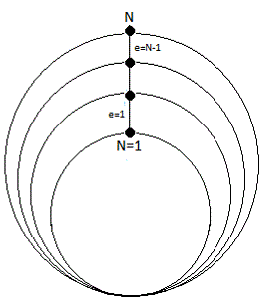Solución de la ecuación de Rayleigh-Plesset por medio del método del elemento finito
Main Article Content
Keywords
cavitación, ecuación de Rayleigh-Plesset, método del elemento finito de Galerkin, presión de vapor, fluido invíscido, fluido incompresible.
Resumen
En este trabajo se plantean soluciones numéricas a la ecuación de Rayleigh-Plesset que describe la evolución de las burbujas en la cavitación. Para ello, se considera el MEFG (Método del Elemento Finito de Galerkin); tal simulación se realiza en un fluido invíscido e incompresible en un campo de temperatura uniforme, una tensión superficial esencialmente constante, y el modelo de cavitación en el flujo siendo la presión interna de las burbujas igual a la presión de vapor del fluido. De esta manera, para el problema se considera el problema de Dirichlet y se obtienen los criterios de frontera que auspician el fenómeno de cavitación a través del crecimiento de las burbujas o cavidades.
PACS: 47.11.Fg, 47,55,db, 47.55.dd
MSC: 76T10, 76B10, 76M10
Descargas
Referencias
[2] C. Tropea and A. Yarin, Springer Handbook of Experimental Fluid Mechanics. Würzburg: Springer, 2007. 148
[3] N. Berchiche, J.-P. Franc, and J.-M. Michel, “A cavitation erosion model for ductile materials,” J. Fluids Eng., vol. 124, no. 3, pp. 601–606, 2002. 148
[4] J. Hundemer and M. Abdel-Maksoud, “Prediction of tip vortex cavitation inception on marine propellers at an early design stage,” in 7th International Symposium on Cavitation, Michigan-USA, 2009, pp. 870–876. 148
[5] A. Philliph and W. Lauterborn, “Cavitation erosion by single laser-produced bubbles,” J. Fluid Mech., vol. 361, no. 1, pp. 75–116, 1998. 148
[6] T. Tao Xing, Z. Li, and S. Frankel, “Numerical Simulation of Vortex Cavitation in a Three-Dimensional Submerged Transitional Jet,” J. Fluids Eng., vol. 124, no. 4, pp. 714–725, 2005. 149
[7] D. Fuster, G. Agbaglah, C. Josserand, S. Popinet, and S. Zaleski, “Numerical simulation of droplets, bubbles and waves: state of the art,” Fluid Dyn. Res., vol. 41, p. 065001 (24pp), 2009. 149
[8] Y. A. O. Xiong-liang and Z. A-man, “A numerical investigation of bubble dynamics based on the potential-flow theory,” Journal of Marine Science and Application, vol. 5, no. 4, pp. 14–21, 2006. 149
[9] M. Ohta, D. Kikuchi, and M. S. Yutaka Yoshida, “Robust numerical analysis of the dynamic bubble formation process in a viscous liquid,” Int. J. Multiph. Flow, vol. 37, no. 9, pp. 1059–1071, 2011. 149
[10] X. Liu and J. Katz, “Cavitation phenomena occurring due to interaction of shear layer vortices with the trailing corner of a two-dimensional open cavity,” Phys. Fluids, vol. 20, no. 4, p. 041702, 2008. 149
[11] G. F. Oweis, J. Choi, and S. L. Ceccio, “Dynamics and noise emission of laser induced cavitation bubbles in a vortical flow field,” J. Acoust. Soc. Am., vol. 115, no. 3, pp. 1049–1058, 2004. 149
[12] M. T. S. Tabar and Z. Poursharifi, “An Experimental Study of Tip Vortex Cavitation Inception in an Axial Flow Pump,” World Academy of Science, Engineering and Technology, vol. 73, no. 1, pp. 527–530, 2011. 149
[13] D. Joseph, T. Funada, and J. Wang, Potential Flows of Viscous and Viscoelastic Fluids. New York: Cambridge University Press, 2007. 150
[14] Y. X-S., A First Course in Finite Element Analysis. United Kingdom: Luviner Press, 2007. 153
[15] T. Chung, Computational Fluid Dynamics. United Kingdom: Cambridge University Press, 2002. 153
[16] C. Johnson, Numerical Solution of Partial Differential Equations by the Finite Element Method. New York: Dover, 2009. 153
[17] T. Chandrupatla and A. Belegundu, Introduction to Finite Elements in Engineering, 2nd ed. U.S.A.: Prentice Hal, 1998. 155
[18] D. Logan, A First Course in the Finite Element Method. U.S.A.: PWS Publishing Company, 1992. 155
[19] D. Young, Iterative Solution of Large Linear Systems. New Yor: Dover, 2003. 156
[20] P. Davis and P. Rabinowitz, Methods of Numerical Integration, 2nd ed. New York: Dover, 2007. 156
[21] Z. Bilicki, M. Giot, and R. Kwidzinski, “Fundamentals of two-phase flow by the method of irreversible thermodynamics,” Int. J. Multiph. Flow, vol. 28, no. 12, pp. 1983–2005, 2002. 157, 160
[22] R. Revellin, S. Sthépane, Sammer, and J. Bonjour., “Local entropy generation for saturated two-phase flow,” Energy, vol. 34, no. 9, pp. 113–1121, 2009. 157, 160
[23] K. S. Suslick and D. J. Flannigan, “Inside a Collapsing Bubble: Sonoluminescence and the Conditions During Cavitation,” Annu. Rev. Phys. Chem., vol. 59, pp. 659–683, 2008. 157
[24] H. Alehossein and Z. Qin, “Numerical analysis of Rayleigh-Plesset equation for cavitating water jets,” Int. J. Numer. Meth. Engng., vol. 72, no. 7, pp. 780–807, 2007. 160
[25] C. Crowe, Multiphase Flow Handbook. USA: CRC Press, 2006. 160
[26] J.-P. Franc and J.-M. Michel, Fundamentals of cavitation. USA: Kluwer Academic Publishers, 2004. 160

